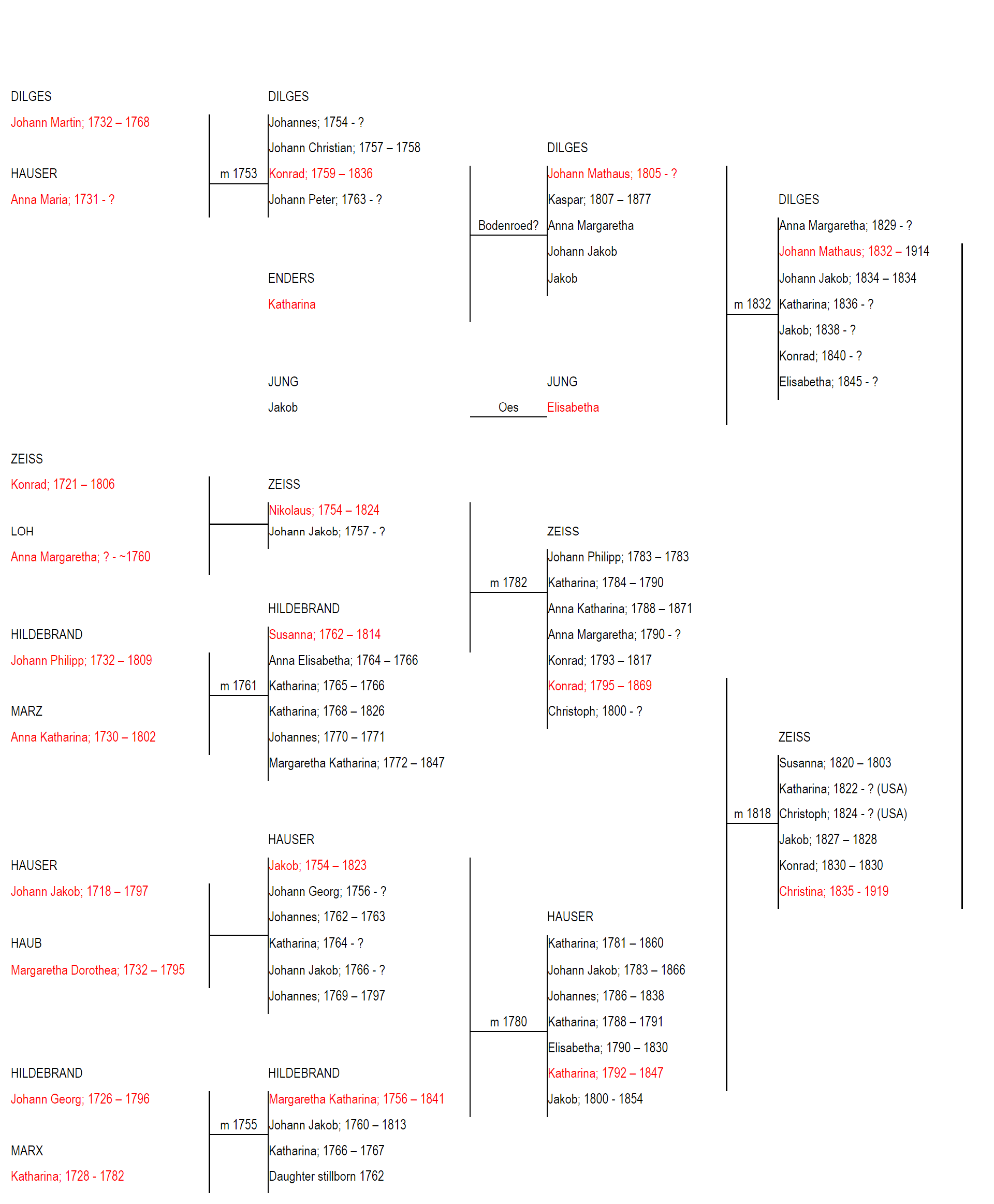Johann Matthaus DILGES 1834-1914
Johann Matthaus was born in the tiny hamlet of Oes – which is now part of Hausen – several km west of Nieder-Weisel in the foothills of the Taunus Ranges. His birth at 7am on 7th March 1832 to Elisabetha Jung, a daughter of Jakob Jung, was registered as her second illegitimate child – an older sister having been born in 1829. The father of both children was Johann Matthaus Dilges, then serving with the 4th Regiment of the army of Grand Duke of Hesse-Darmstadt. After receiving permission from his Colonel, he and Elisabetha were married in the parish church at Hausen on 27th April, seven weeks after their son’s birth. As the bridegroom formally acknowledged fatherhood of both the children they were legitimised by the contract of marriage.
The forebears of Johann Matthaus had farmed in the village for generations. Before the upheaval of the Napoleonic War the family enjoyed a heritable tenure over their holdings, but this was lost in the administrative changes that took place in the early 1800s. Johann Matthaus senior had to look for alternate means of earning a living and had decided to stay in the army as a mercenary after serving his required period of conscription. He and his wife had five children in wedlock, one of who died soon after birth. They gained a rudimentary education at the one-class school in Hausen before going out, after confirmation at 14, to try to earn a living. Johann Matthaus junior entered the trade of black-smithing and left his home village to gain experience as a journeyman. It was on these travels that he met Christina, youngest daughter of Konrad Zeiss, a linen-weaver in nearby Nieder-Weisel, and his wife Katharina nee Hauser, daughter of the village baker; she was three years his junior.
Romance blossomed and the couple exchanged vows before the altar in the church at Nieder-Weisel. The godfather of the groom, his uncle Johann Matthaus Jung, came from Hausen to support him, and the bride’s mother’s father, Johann Jakob Hauser IX, represented her family. Christina produced their first child, named in memory of her mother, on 21st July 1856, but Johann Matthaus had already decided to join the exodus to Victoria’s goldfields. Leaving the baby with her foster mother (one of Christina’s sisters), they sailed on 27th May 1857 on “Sir W F Williams” with 25 other villagers. There were many bounty passengers for Hobart Town aboard so these Nieder-Weiselerns were the first ever to see Tasmania. They finished the journey to Melbourne by steamer on 31st August – three weeks before their daughter died in Nieder-Weisel.
Johann Matthaus tried his luck on the Ballarat goldfields, perhaps successfully, as he was soon able to go set himself up in business as a blacksmith. He was one of the earliest of the Nieder-Weisel emigrants to become a British citizen, his letters of naturalisation being granted on 18th July 1864. The Dilges smithy in Plank Street Ballarat soon became both a hive of business activity and a favoured meeting spot for the many Germans living in the area.
In the background Christina took on the less public task of producing and raising their family of three sons and five daughters. Inevitably, there were heartbreaks – their first-born son and two of the girls succumbed to childhood maladies.
Johann Matthaus was successful in his business and became a hotel licensee after he retired from black-smithing. He was active in community affairs and in the German Verein, whose members provided the escort when he was laid to rest in the Old Cemetery at Ballarat on 21st January 1914. He was accorded a unique memorial 50 years later when a replica of his smithy was featured in a mining museum at Sovereign Hill Ballarat, visited by scores of thousands of tourists every week.
Christina lived through the war years, becoming naturalised in her own right in 1914. She died in 1919 and was interred with Johann Matthaus.
View Johann's Family Chart

